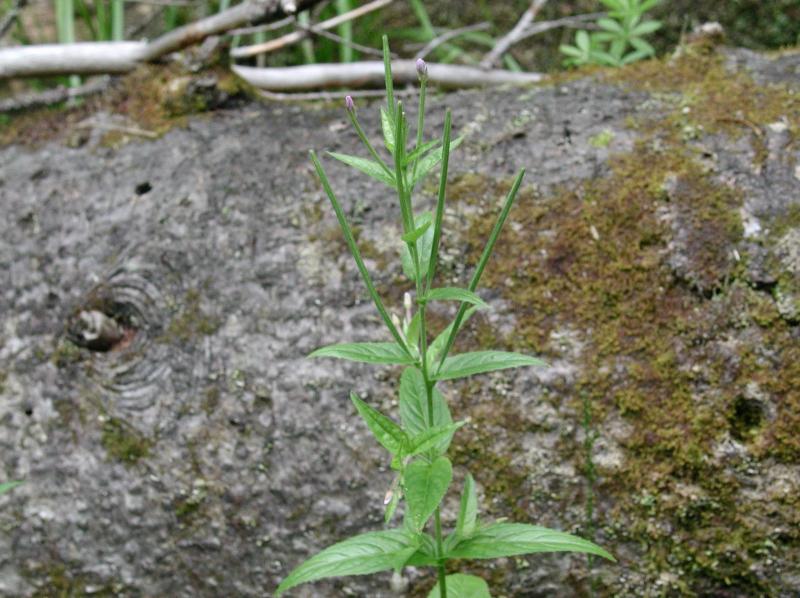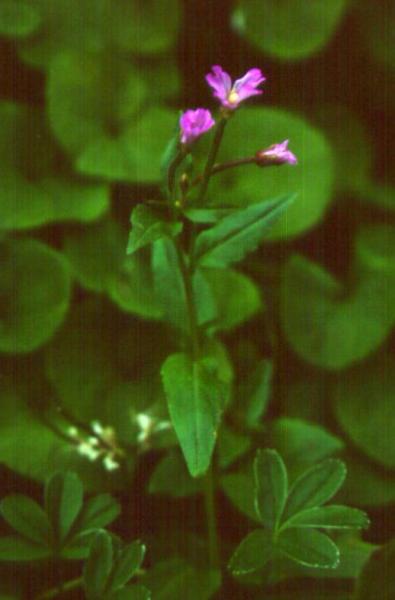Alpine Willowherb
Epilobium hornemannii ssp. hornemannii None
- Class
- Dicotyledoneae (Dicots)
- Family
- Onagraceae (Evening-Primrose Family)
- State Protection
- Endangered
Listed as Endangered by New York State: in imminent danger of extirpation in New York. For animals, taking, importation, transportation, or possession is prohibited, except under license or permit. For plants, removal or damage without the consent of the landowner is prohibited.
- Federal Protection
- Not Listed
- State Conservation Status Rank
- S1
Critically Imperiled in New York - Especially vulnerable to disappearing from New York due to extreme rarity or other factors; typically 5 or fewer populations or locations in New York, very few individuals, very restricted range, very few remaining acres (or miles of stream), and/or very steep declines.
- Global Conservation Status Rank
- G5T5
Secure globally - Both the species as a whole and the subspecies/variety are common in the world; widespread and abundant (but may be rare in some parts of its range).
Summary
Did you know?
The genus Epilobium was named by the Swedish botanist Linnaeus, the creator of our modern system of taxonomy. "Epilobium" is derived from Greek, and may be translated as "upon a capsule", a reference to how each flower sits atop an elongated ovary. The ovary then ripens into a long cigar-shaped fruit (the capsule). Epilobium species have long been used for medicinal purposes, and are the subject of current research into their anti-inflammatory and anti-bacterial properties.
State Ranking Justification
There are currently only 5 confirmed locations for this species in New York. Only one of these has ever been observed to have a population of more than 50 individuals, and no population count has ever been made at 2 of the other sites. There are 2 historical occurrences, from Essex and Jefferson counties.
Short-term Trends
Several of the known sites for this species have been visited only once, or have never been accurately counted, so the population trends of this species in New York is unknown.
Long-term Trends
Long-term trends are unknown.
Conservation and Management
Threats
One population is adjacent to a hiking trail, where trampling and trail maintenace could be potential threats. Other populations growing on open limestone outcrops adjacent to wetlands could be threatened by successional changes to the site, or by rising water levels. No negative impacts from these threats have been observed to date.
Conservation Strategies and Management Practices
No management needs are apparent at the sites for this species in New York.
Research Needs
Only 1 of the extant populations of this plant has been observed since 1989. Current assessments of population size and threats are needed for all the extant sites, and both historical locations need to be searched.
Habitat
Habitat
In New York Epilobium hornemanii ssp. hornemanii is associated with rock outcrops. It has been found growing on alvar pavement and other exposed, calcareous bedrock in northwestern New York, and at waterfalls and cliffs in the Adirondacks.
Associated Ecological Communities
- Alvar pavement grassland
(guide)
This community consists of exposed, flat limestone or dolostone pavement with grassy or mossy patches interspersed throughout. Some examples may be solely grassland with no pavement.
- Alvar shrubland*
(guide)
A shrub-dominated community that has over 25% cover of tall, short, and dwarf shrubs. There are often deep crevices or grikes in the limestone pavement; trees and shrubs are often rooted in the grikes.
- Alvar woodland*
(guide)
A subset of the limestone woodland community restricted to the alvar region in Jefferson County, New York.
- Calcareous red cedar barrens
(guide)
A small-patch calcareous rocky summit community occurring on dry, south-facing to southwest-facing slopes and low summits. These sites are characterized by stunted, sparse woodlands with small grassland openings.
- Cliff community
(guide)
A community that occurs on vertical exposures of resistant, non-calcareous bedrock (such as quartzite, sandstone, or schist) or consolidated material; these cliffs often include ledges and small areas of talus.
- Spruce-northern hardwood forest
(guide)
A mixed forest that occurs on lower mountain slopes and upper margins of flats on glacial till. This is a broadly defined community with several variants; it is one of the most common forest types in the Adirondacks. Codominant trees are red spruce, sugar maple, American beech, yellow birch, and red maple, with scattered balsam fir.
* probable association but not confirmed.
Associated Species
- Bryum
- Cirsium muticum (swamp thistle)
- Epilobium ciliatum
- Juniperus virginiana
Range
New York State Distribution
In New York this herb is known only from the Adirondack High Peaks area and from limestone outcrops and pavement barrens near Lake Ontario.
Global Distribution
Epilobium hornemanii has a circumboreal distribution, occurring in high-latitude areas of North America and Eurasia. It is found in much of Canada, and in the western US from the Rocky Mountains west, but in the eastern U.S. is known only from New York, New Hampshire, and Maine.
Identification Comments
General Description
Epilobium hornemannii ssp. hornemannii is a perennial herb which can spread by prostate stems, forming a mat. It has unbranched stems 15 to 45 centimeters tall. It has entire to somewhat toothed leaves about 1.5 to 4.5 centimeters long and half as wide. The tiny pink flowers are on stems emerging from the base of the leaves, and are only about 2 to 6 centimeters long. As in all Epilobium species, the fruits are cigar-shaped capsules, erect at first then drooping as they mature. In this species they are about 3.5 to 7.5 centimeters long.
Best Life Stage for Proper Identification
This species may be identified vegetatively but is more easily noticed and identified when it is flowering or fruiting, in July or August.
Similar Species
Epilobium hornemannii can be distinguished from most other species of Epilobium occurring in New York by its relatively wide, short leaves and only sparsely pubescent or puberulent leaves and stems. Epilobium ciliatum tends to be taller (3 to 10dm) and have stems branching above the base, and it grows from basal rosettes, rather than from rhizomes as does E. hornemannii.
Best Time to See
Flowers in July or August (Gleason and Cronquist 1991). In New York this species has been observed in flower as early as June 6 and as late as September 4.
- Flowering
- Fruiting
The time of year you would expect to find Alpine Willowherb flowering and fruiting in New York.
Alpine Willowherb Images
Taxonomy
Alpine Willowherb
Epilobium hornemannii ssp. hornemannii None
- Kingdom Plantae
- Phylum Anthophyta
- Class Dicotyledoneae
(Dicots)
- Order Myrtales
- Family Onagraceae (Evening-Primrose Family)
- Order Myrtales
- Class Dicotyledoneae
(Dicots)
- Phylum Anthophyta
Additional Common Names
- Alpine Willow-herb
Synonyms
- Epilobium alpinum L. [Misapplied to New York specimens.]
- Epilobium alpinum var. nutans (Hornem.) Hooker
- Epilobium anagallidifolium Lam. [Misapplied to New York specimens.]
- Epilobium nutans Hornemann
Additional Resources
References
Edinger, Gregory J., D.J. Evans, Shane Gebauer, Timothy G. Howard, David M. Hunt, and Adele M. Olivero (editors). 2002. Ecological Communities of New York State. Second Edition. A revised and expanded edition of Carol Reschke's Ecological Communities of New York State. (Draft for review). New York Natural Heritage Program, New York State Department of Environmental Conservation. Albany, NY. 136 pp.
Gleason, Henry A. and A. Cronquist. 1991. Manual of Vascular Plants of Northeastern United States and Adjacent Canada. The New York Botanical Garden, Bronx, New York. 910 pp.
Haines, Arthur and Thomas F. Vining. 1998. Flora of Maine. A Manual for Identification of Native and Naturalized Vascular Plants of Maine.
Holmgren, Noel. 1998. The Illustrated Companion to Gleason and Cronquist's Manual. Illustrations of the Vascular Plants of Northeastern United States and Adjacent Canada. The New York Botanical Garden, Bronx, New York.
Mitchell, Richard S. and Gordon C. Tucker. 1997. Revised Checklist of New York State Plants. Contributions to a Flora of New York State. Checklist IV. Bulletin No. 490. New York State Museum. Albany, NY. 400 pp.
New York Natural Heritage Program. 2010. Biotics database. New York Natural Heritage Program. New York State Department of Environmental Conservation. Albany, NY.
New York Natural Heritage Program. 2024. New York Natural Heritage Program Databases. Albany, NY.
Voss, E.G. 1985. Michigan Flora. Part II. Dicots (Saururaceae - Cornaceae). Cranbrook Institute of Science and University of Michigan Herbarium. Ann Arbor, Michigan. 724 pp.
Weldy, T. and D. Werier. 2010. New York flora atlas. [S.M. Landry, K.N. Campbell, and L.D. Mabe (original application development), Florida Center for Community Design and Research http://www.fccdr.usf.edu/. University of South Florida http://www.usf.edu/]. New York Flora Association http://newyork.plantatlas.usf.edu/, Albany, New York
Weldy, Troy W. and David Werier. 2005. New York Flora Atlas. [S.M. Landry, K.N. Campbell, and L.D. Mabe (original application development), Florida Center for Community Design and Research. University of South Florida]. New York Flora Association, Albany, NY. Available on the web at (http://newyork.plantatlas.usf.edu/).
Links
About This Guide
Information for this guide was last updated on: May 22, 2008
Please cite this page as:
New York Natural Heritage Program. 2024.
Online Conservation Guide for
Epilobium hornemannii ssp. hornemannii.
Available from: https://guides.nynhp.org/alpine-willow-herb/.
Accessed July 27, 2024.

